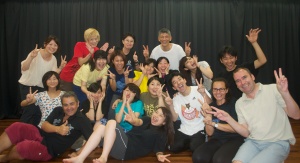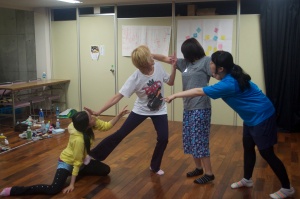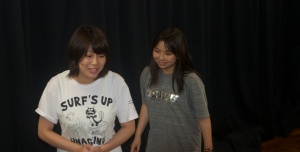We are thrilled to be returning to Tokyo this summer to deliver a series of workshops on Acting, the demystification of Shakespeare and the art of storytelling through Theatre.
Very often, when we think of Japanese Theatre, we either think of its traditional forms such as *Noh, *Kabuki and *Bunraku or we think of high tech, off the wall pieces as demonstrated by a recent blog by Kate Beale.
But our journey to Tokyo takes us back to the very core of what Theatre, for us at StoneCrabs, is all about: storytelling and the personal connection an actor has to make with the world of the story in a very special meeting between the objective/want of the character and their own imagination. And this is what we have been asked to bring to Tokyo, a reminder, I suppose, of the humanity of theatre where the actor, the language and the story are the main focus.

Franko, Kwong and Tereza with the actors – Interact2014 StoneCrabs Theatre in Tokyo. Photo by Alan Figueiredo-Stow
We have had many meetings where we have discussed, planned and devised games, exercises (some old, some newly conceived) towards exploring Shakespeare’s A Midsummer Night’s Dream (the selected text) with the groups, (we are working with a very young group of actors who are still learning and another group of more experienced actors, some who have worked with us in the past). Our main preoccupation is that the games and exercises we will be using will help us connect with the text in such a way to unlock our imagination and support the creative construction of a new experimental ‘Dream’. Our starting point for the work is always imagery and energy games, as we find that these allow for an interaction that will go beyond language, although language/voice/sound in itself is, for us, very important too – particularly a language that is highly poetic, sonorous and extravagant such as Shakespeare’s; we will play, deconstruct, but we will use the text with the original words.
To quote Cicely Berry “The more techno-speak takes over, the more we will disable our belief in language. Words have the power to disturb, surprise, delight and provoke, and they are happening in the moment – and between people.” – which summarises what we are trying to achieve with our work in Tokyo, to demystify Shakespeare and allow us actors, directors, theatre makers to rediscover the power of the word, and how that helps us to create and engage an audience craving for old tales.
None of us speak Japanese and the work is carried out through our wonderful translator/assistant director, Ecco-san; Ecco had spent time in London as a theatre practitioner, and this made our work very fluent as with speed, the conduct of our discussions, floor exercises and scene rehearsals were smooth and joyful. However, there might be some nuances and subtlety of language that get ‘lost in translation’, which often resulted in hilarious misconstruction.
We are ‘Exploring The Dream’ through the love relationships in the story: Theseus & Hippolyta; Hermia & Lysander, Helena and Demetrius, and Oberon and Titania, and have thrown in a bit of Puck for some fairy cheek. Our actors launched into the work with great aplomb, excited by the playful energy of the text, journeys of the characters and discovering thoughts, objectives, imagery, and the physicality of text and performance.
It is interesting to hear in Japanese Shakespeare’s text of iambic pentameter, rhyme, blank verse, intense imagery, in a language that has a very different spoken rhythm and sounds from English, let alone Shakespearean language. In the translation we are working from, much of the rhyme is lost, and certainly the iambic. What to make out of this? So, we concentrated on the ‘meaning’ of dialogue, the description of situations (as by Titania to Oberon of their quarrel), the imagery and its connection to the words spoken; we encouraged the sharing out of thoughts to the audience, and immerse ourselves into a world of magic that reflects the world of humankind. In understanding that when we ‘dream’ of things beyond the clouds, our lives take on the world of Oberon and Titania, are connected by Bottom’s ‘change’ to that world.
The time here in Tokyo makes real our ‘dream’ of taking theatre back to its storytelling roots, connecting the personal to the magical, with a little help from our Japanese friends. The weather has been kind to us too: hot sunny days with warm balmy nights, some bento to warm our stomachs and light sushi in the day to keep us going.
The process of exchanging ideas, techniques and work continues beyond our time here: as we leave Tokyo – we start reflecting on this ‘dream’ and renewing our plans to continue the work when we return in 2015.
“I have had a dream, past the wit of a man to say what dream it was” – Bottom
Franko Figueiredo, Kwong Loke & Tereza Araujo
*Noh is a major form of classical Japanese musical drama that has been performed since the 13th century. Many characters are masked, with men playing male and female roles. Noh Theatre
*Kabuki is a classical Japanese dance-drama. Kabuki theatre is known for the stylization of its drama and for the elaborate make-up worn by some of its performers. Kabuki Theatre
*Bunraku is a form of traditional Japanese Puppet Theatre, founded in Osaka in 1684. Bunraku Theatre


